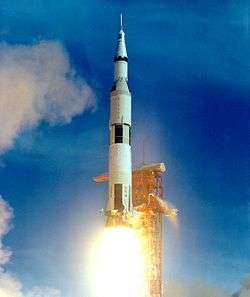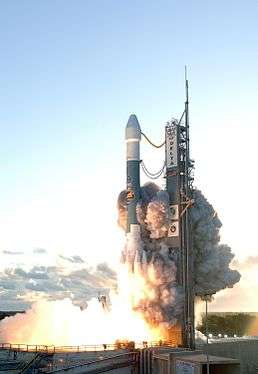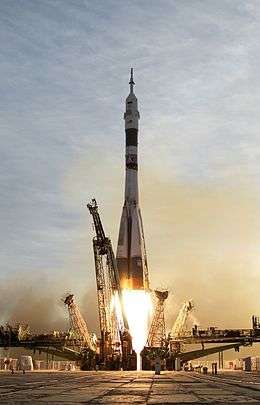Space vehicle
A space vehicle or spaceship is a rocket-powered vehicle used to transport robotic spacecraft or people between the Earth's surface and outer space. The earliest space vehicles were expendable launch systems, consisting of two parts: a single or multistage rocket launch vehicle, which carried a spacecraft payload (satellite or crew-bearing space capsule) which were relatively small portions of the total vehicle size and mass.[1] An early exception to this, the United States Space Shuttle space vehicle, which flew from 1981 to 2011, consisted of a reusable orbiter spaceplane carrying crew and payload, supported by an expendable external propellant tank and two reusable solid-fuel booster rockets.
.jpg)
As of January 2020, most space vehicles in production use are still expendable systems, although reusable launch systems have been envisioned since the late 1960s and are currently under development.[2]
Visionary space ships
In the 1865 Jules Verne novel From the Earth to the Moon, successful attempts are made to launch three people in a projectile with the goal of a Moon landing. In 1880, The Pall Mall Gazette described Verne’s Columbiad as a "space-ship" — the first recorded use of this term.[3]
The concept of a "space ship" (or "rocket ship") was further developed in twentieth century science fiction such as Flash Gordon, as a self-contained, presumably rocket-powered, unitized vehicle capable of reaching an extraterrestrial destination keeping its structure intact, and requiring only refueling, like an airplane. Real-world rocket technology did not make this possible; while the airplane requires an amount of fuel occupying a relatively small fraction of the total size and mass, the rocket requires an oxidizer in order to operate in the vacuum of space.[4] It also cannot use atmospheric air as its propellant; this function is served by the high-volume and high-mass fuel and oxidizer. Also, the high amount of energy required to reach at least low Earth orbital speed requires an extremely high proportion of propellant to dry vehicle mass. Also, mid-twentieth century structural technologies made it impossible to construct a single set of propellant tanks capable of holding enough mass to reach the required velocity. Thus, expendable multi-stage launch vehicles were the necessary design choice when spaceflight began in the late 1950s. However, starting in the 1990's developmental work began on such unitary single stage to orbit (SSTO) spacecraft with projects like the X-33, the Roton Rotary Rocket, McDonnell Douglas DC-X, and Reaction Engines Skylon. By 2020, most SSTO developmental projects had failed with the exception of Skylon, which continues development.
Expendable space vehicles

A majority of launch systems currently in use are expendable, designed to carry a single payload into space but not for recovery and reuse. They typically consist of several stages which detach in sequence as the vehicle gains speed and altitude and propellant is exhausted.
Reusable space vehicles
Reusable launch systems are capable of launching multiple payloads and can be recovered after each use. No entirely reusable system is currently employed by any space program, however, reusable systems are in active development by private space enterprises such as SpaceX and Blue Origin.
Gallery
 A Delta II 7925 expendable rocket launching NASA's Dawn mission.
A Delta II 7925 expendable rocket launching NASA's Dawn mission. A Russian Soyuz-FG expendable system, part of the Soyuz TMA-5 mission.
A Russian Soyuz-FG expendable system, part of the Soyuz TMA-5 mission.
References
- "Expendable Launch Vehicle Investigations - Space Flight Systems". Space Flight Systems. Retrieved 2016-02-09.
- Spudis, Paul D. "Reusable Launch Vehicles and Lunar Return". Air & Space Magazine. Retrieved 2016-02-09.
- https://howthingsfly.si.edu/ask-an-explainer/what-year-was-word-spaceship-first-used
- "PROPELLANTS". history.nasa.gov. Retrieved 2016-02-09.